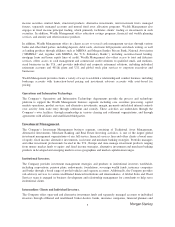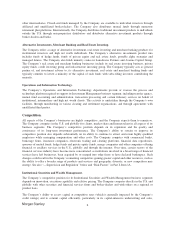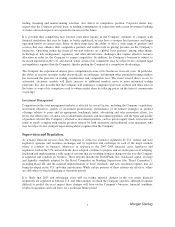Morgan Stanley 2014 Annual Report Download - page 19
Download and view the complete annual report
Please find page 19 of the 2014 Morgan Stanley annual report below. You can navigate through the pages in the report by either clicking on the pages listed below, or by using the keyword search tool below to find specific information within the annual report.
U.S. Subsidiary Banks.
U.S. Banking Institutions. MSBNA, primarily a wholesale commercial bank, offers commercial lending and
certain retail securities-based lending services in addition to deposit products. Certain foreign exchange activities
are also conducted by MSBNA. MSBNA is an FDIC-insured national bank that is subject to supervision,
regulation and examination by the OCC.
MSPBNA offers certain mortgage and other secured lending products primarily for customers of its affiliate
retail broker-dealer, Morgan Stanley Smith Barney LLC (“MSSB LLC”). MSPBNA also offers certain deposit
products, as well as prime brokerage custody services. MSPBNA is an FDIC-insured national bank that is subject
to supervision, regulation and examination by the OCC.
Effective October 1, 2013, the lending limits applicable to the Company’s U.S. Subsidiary Banks were revised to
take into account credit exposure arising from derivative transactions, securities lending, securities borrowing
and repurchase and reverse repurchase agreements with third parties.
In September 2014, the OCC issued final risk governance guidelines to establish heightened standards for large
national banks, and the guidelines apply to both MSBNA and MSPBNA. The final guidelines set minimum
standards for the design and implementation of a bank’s risk governance framework and the oversight of that
framework by a bank’s board of directors.
Prompt Corrective Action. The Federal Deposit Insurance Corporation Improvement Act of 1991 provides a
framework for regulation of depository institutions and their affiliates, including parent holding companies, by
their federal banking regulators. Among other things, it requires the relevant federal banking regulator to take
“prompt corrective action” (“PCA”) with respect to a depository institution if that institution does not meet
certain capital adequacy standards. Current PCA regulations generally apply only to insured banks and thrifts
such as MSBNA or MSPBNA and not to their parent holding companies. The Federal Reserve is, however,
subject to limitations, authorized to take appropriate action at the holding company level. In addition, as
described above, under the systemic risk regime, the Company will become subject to an early remediation
protocol in the event of financial distress. The Dodd-Frank Act also formalized the requirement that bank holding
companies, such the Company, serve as a source of strength to their U.S. bank subsidiaries and commit resources
to support these subsidiaries in the event such subsidiaries are in financial distress.
Transactions with Affiliates. The Company’s U.S. Subsidiary Banks are subject to Sections 23A and 23B of
the Federal Reserve Act, which impose restrictions on “covered transactions” with any affiliates. Covered
transactions include any extension of credit to, purchase of assets from, and certain other transactions with an
affiliate. These restrictions limit the total amount of credit exposure that the Company’s U.S. Subsidiary Banks
may have to any one affiliate and to all affiliates, as well as collateral requirements, and they require all such
transactions to be made on market terms. Effective July 2012, derivatives, securities borrowing and securities
lending transactions between the Company’s U.S. Subsidiary Banks and their affiliates became subject to these
restrictions. These reforms place limits on the Company’s U.S. Subsidiary Banks’ ability to engage in derivatives,
repurchase agreements and securities lending transactions with other affiliates of the Company. The Federal
Reserve has indicated that it will propose a rulemaking to implement these more recent restrictions, but has not yet
done so.
In addition, the Volcker Rule generally prohibits covered transactions between (i) the Company or any of its
affiliates and (ii) covered funds for which the Company or any of its affiliates serve as the investment manager,
investment adviser, commodity trading advisor or sponsor or other covered funds organized and offered by the
Company or any of its affiliates pursuant to specific exemptions in the Volcker Rule.
FDIC Regulation. An FDIC–insured depository institution is generally liable for any loss incurred or expected
to be incurred by the FDIC in connection with the failure of an insured depository institution under common
control by the same bank holding company. As commonly controlled FDIC-insured depository institutions, each
of MSBNA and MSPBNA could be responsible for any loss to the FDIC from the failure of the other. In
15
























